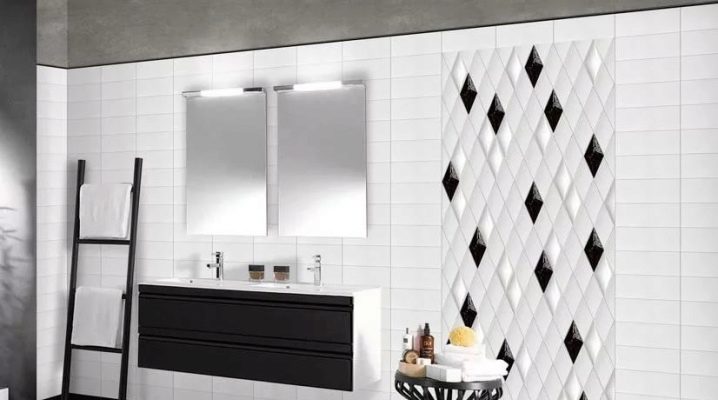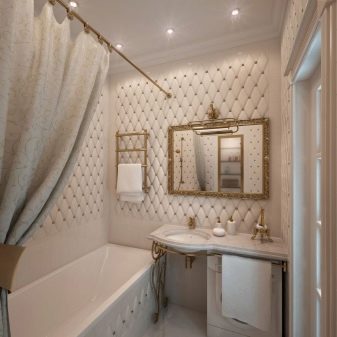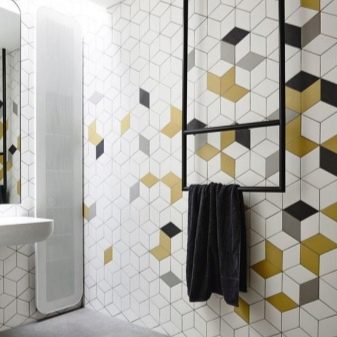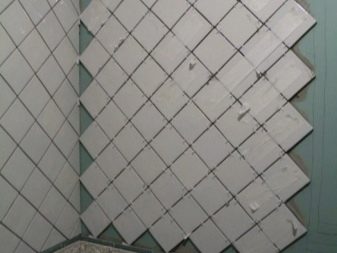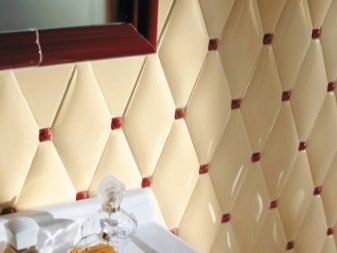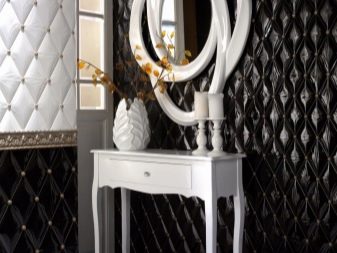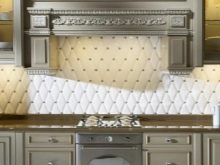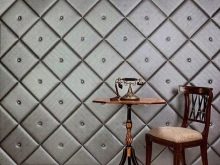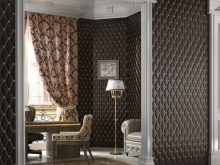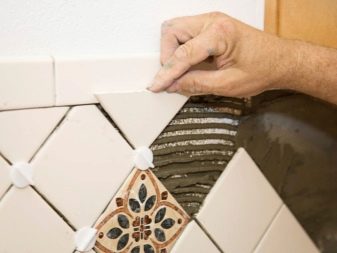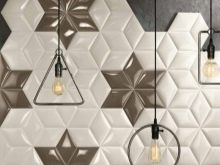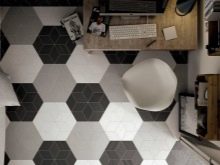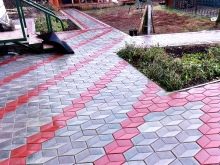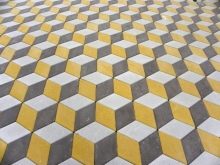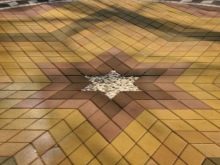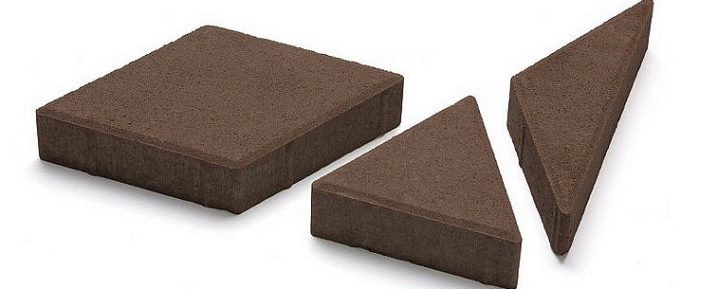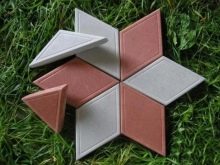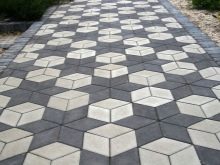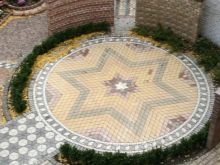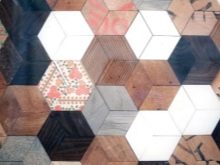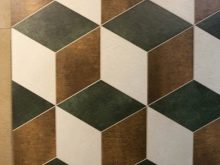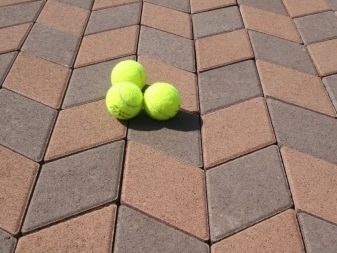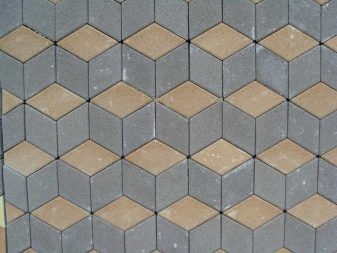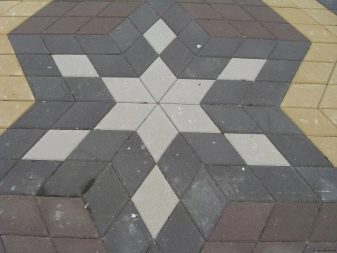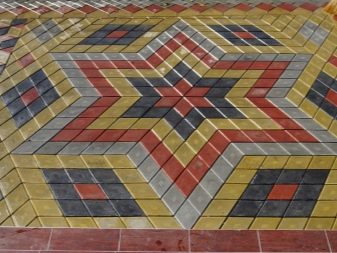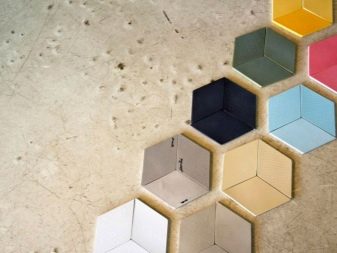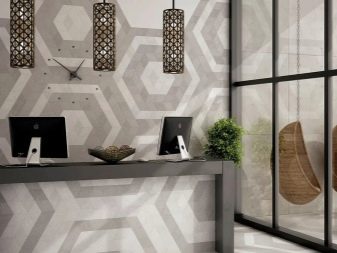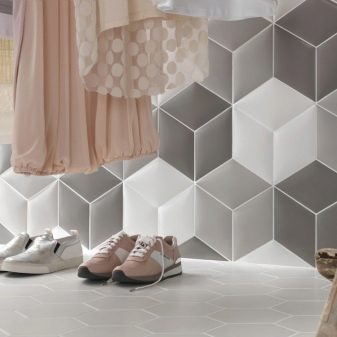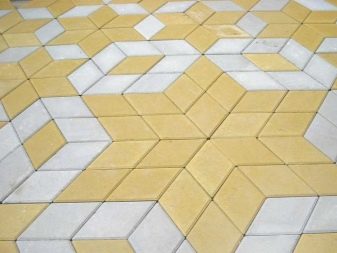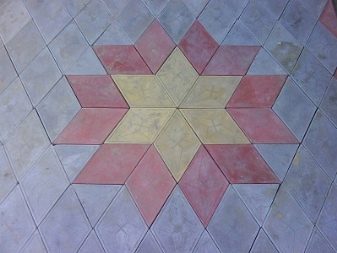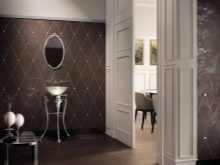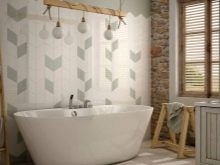Tile-rhombus in interior design
Diamond-shaped tile - building material, which revet the walls, giving them an original pattern. Such a picture combines the features of rigor with luxury. Stylish finish looks very unusual.
Features and benefits
Rhombus ceramic tile is the material for a typical tile facing, while retaining all the characteristics of this type of finish. Among the many advantages of such products should be distinguished durability, wear resistance, as well as simple maintenance. There are only two types of products, with which a rhomboid pattern is created:
- Square, which, with proper installation will create a three-dimensional picture of the decor.
- Diamond-shaped quadrangular tiles with different degrees of angles.
Understanding in more detail in the finishing materials, it is important to highlight ceramic tiles to create a rhomboid pattern.Today, the most sought after models that, after laying resemble a voluminous coating of fabric or leather. Their appearance is similar to the interior upholstery carriages, which are often used by the aristocrats of Europe in the nineteenth century. The design of this veneer really inspires a sense of luxury, because it looks rich.
The standard size of one segment is 100x200mm. The color scheme is wider - the colors can be: white, burgundy (leather), blue, green, black. Like any ceramic tile, This material can have a glossy surface, which is great for a bathroom designed in a monarchical style.. As for the inserts framing the elements, they can be made in the form of a dense suture with a thread, which enhances the similarity with natural materials.
This design is appropriate for the bedroom, study, bathroom and other rooms, giving them a luxurious look.
It is not required to cover the entire wall with this finish. You can revet the area near the bed, the body of the fireplace or part of the kitchen.
Kinds
Square tile
The characteristics of this variant are virtually identical with rhomboid elements.This tile is also made with a glossy surface or it may look like leather. It can be attached gold inserts, as well as parts in the form of a seam. Standard sizes of such large-scale products are 200x200mm, and small ones - 100x100mm.
Mosaic pattern
The versatility of quadrangular tiles makes it possible to perform various original patterns in the form of stars, a grid, or three-dimensional images. For such drawings, special inserts made of metal, glass, wood and other suitable materials are provided.
Paving slabs
Since this article is about a unique decoration of diamond tiles, it is impossible to ignore the common material for the decoration of sidewalks. In addition to a durable, wear-resistant coating, such models are able to create an original design that will perfectly complement their surrounding design.
This option allows you to create a three-dimensional image due to the configuration of the color palette, because to depict a multi-pointed star or "cube" is not difficult.
A variety of rhomboid paving slabs
To date, there are no clear requirements put forward by the state for the manufacture of tiles, because each manufacturer provides products created by its own technology.As a rule, sizes vary from 15x25cm to 19x33cm. For pedestrian pavement, the thickness of stones can be from 4 cm, and for highways it often reaches 7 cm.
There are individual products that China manufactures, designed to facilitate the styling process. These are the peculiar "halves" of a diamond:
- The transverse half is an isosceles triangle, the upper angle of which is sharper than the side ones.
- The longitudinal half is a triangle with a blunt tip.
Despite its purpose (to reduce the cost of laying due to the exclusion of sawing tiles), such products are much more expensive, because it is rarely used in the work.
As for coloring, it can cover only the upper (front) part of a stone up to 3 cm thick, and also completely paint a rhombus. There are more than 30 different colors on the market.
The border that decorates the tiled sidewalks and courtyards, also happens in different colors. It may coincide with the color of the tile, or be different from it. Its role depends on it - it can only limit the sides of the coating, merging with it, and can serve as a separate element of the ornament, standing out against the general background.
Drawing pattern
For many types of FEM (figured paving elements) there are separate laying patterns that describe the position of the longitudinal seams or the elements themselves relative to each other. It also describes how to install materials of different colors to form a specific pattern. A distinctive feature of the rhomb-shaped paving slabs is the correct symmetrical shape, which facilitates the process of installation:
- The connection of three identical rhombic elements forms a hexagon of regular shape.
- Six of these tiles are able to form a six-pointed star.
- When laying will not have to trim the elements, which will reduce the cost of the work.
The combination of figures of three different colors allows you to create three-dimensional images.
Laying patterns
Due to the symmetry of the FEM, the segments are stacked next to each other, joining the edges. Drawing can be represented exclusively from a tile of different colors. The seams between the elements cannot be shifted, however, it is possible to plan in advance the placement of diamonds in rows relative to each other in curved and rounded sections.
You still have to cut the segments, because whole diamonds can fit in the sidewalk with only one specific scheme:
- No image drawing.
- It is necessary to dock the side edges of the first row with the curb.
- Lay an even number of rows to achieve symmetry.
But here you can not do without cutting tiles on the end parts of the pavement.
Six-pointed star
It is recommended to use this ornament exclusively on large areas. The scheme for the picture is as follows:
- Take six identical segments.
- The sharp corners of six diamonds are connected at one point - the center of the star.
- Then you need to create a contour with six diamonds of a different color.
Such figures can touch each other with “rays”, and also be separated by other tiles (for considerable distances).
Hexagon
No less popular is the option of laying, in which a regular hexagon is formed. Some people call it a “cube” (it looks like a cube, the view of which opens from one of the corners).
Here, to form a picture, you need to take three diamonds and connect their obtuse angles at one point. The figure has a smaller (compared to the star) size, so it is easier for it to arrange the flooring. Convex options make out the same.
3D drawing
To create a three-dimensional image, you need to use the “hexagon” scheme. In this case, all three elements must be of different colors. These figures are located one next to the other (in a clear sequence). You can complicate the drawing by applying other schemes that give the pattern three-dimensionality, which will pleasantly surprise the guests of the courtyard.
Whatever the 3D-drawing, the masters recommend sticking to a simple combination - two dark elements from the bottom and one light from the top. So “cube” will seem more realistic. In this sequence, the image will resemble the steps of several stairs located one next to the other.
Note that the combination of certain colors does not give a 3D effect. In this case, it turns out "flower" - another scheme for laying paving slabs.
Geometric figure
The most common version of the design of the yard - a consistent or chaotic complex pattern. A canvas of hexagons fills the circle well, and for large areas you can lay out stars, snowflakes and other multi-faceted figures.
Summing up
Diamond tile regardless of the destination, whether it be wall cladding in the bathroom, kitchen,either the pavement or courtyard can create an original design, adding a unique pattern to the decor that will never get bored. In addition, due to its shape, it is easy to lay it, and it serves as a convenient material for creating paintings, which is why it is so in demand among designers and decorators.
But you should be careful when using the tile, because the pattern is created forever, and then it will be extremely difficult to remove irregularities or mistakes.
Master class on creating a pattern in the form of rhombus tiles, see below.
